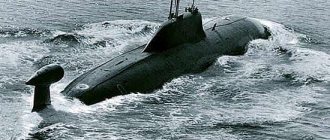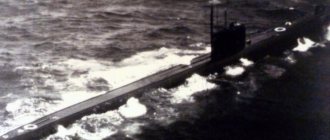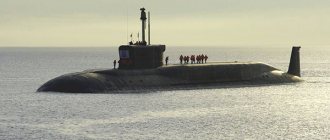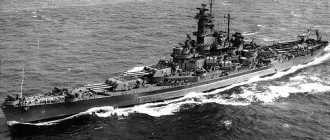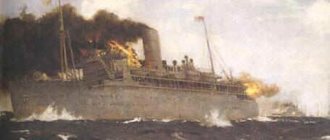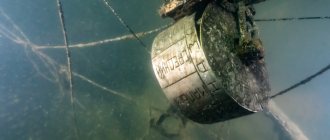According to the traditions of the American Navy, ships and submarines “lost at sea” are not decommissioned from service, but are transferred to the symbolic “Eternal Patrol”.
A story of the Cold War and secrets. Geopolitical opponents demonstrated achievements and hid failures. Sometimes you had to keep a secret from your own people. Thus, materials about the sinking of the American nuclear submarine Thresher are still classified.
A miracle of technology
In fact, this joke describes the real situation of submariners - dozens, or even hundreds of people perform their tasks in a hostile environment, under the terrifying pressure of the thickness of the sea depths, separated from inevitable death only by a layer of metal.
And the reliability of this metal structure in the full sense of the word determines who lives and who dies. The late 1950s and early 1960s marked a time of scientific and technological revolution in the history of the submarine fleet. Boats of a new era were entering service - nuclear-powered ships, on whose superpowers both sides in the Cold War were betting.
The arms race forced scientists, designers, and shipbuilders to work at an accelerated pace, and military sailors to master the latest technology literally on the fly.
As has often happened in history, in the first years of the development of nuclear submarines, a deceptive feeling of the invulnerability of these ships arose. The retribution for this delusion followed very quickly.
The American nuclear submarine Thrasher, the lead ship of the new project, was launched in July 1960. The event took place in a solemn atmosphere at the Portsmouth shipyard. The crew, consisting of first-class sailors, began testing the ship in 1961. Like the Soviet submarine K-3 Leninsky Komsomol, Thrasher took an active part in various tests and trials, the results of which should in the future allow improvements to be made in the design of subsequent ships of this type.
As with any new equipment, the Thrasher experienced many minor accidents and technical problems, to which the military command for the time being turned a blind eye. At the beginning of 1963, the submarine collided with a tug and was forced to stop for repairs to one of the ballast tanks.
However, all these little things did not shake confidence in the reliability of the Thrasher.
Unpleasant discoveries
The commission was able to find out that on the Thrasher, launched on April 9, 1960, already in the first year of operation, 875 defects were discovered, 130 of which were related to design features, and 5 turned out to be catastrophically dangerous. It turned out that the work was carried out without appropriate training of specialists: a large number of private subcontractors were involved in order to reduce the cost and receive “gratitude”, and there was no proper control over them. Some of the work was carried out using outdated technologies. So, instead of welding pipelines, which was common at that time, they used soldering, but even with this, a quarter of the seams were defective (this was shown by control tests). Not all work was reflected in the drawings, which led to absurd situations: during the exercises, the submariners were unable to find the shut-off valves, which, for the convenience of work, were moved to another place... The shipyard management wanted to deliver the Thrasher within the period specified in the contract, and therefore for defects they just closed their eyes. But it was not only the “shoals” of the shipbuilders that led to the tragedy. By coincidence, the Thrasher went out on its last voyage with a new captain - 35-year-old Lieutenant Commander John Harvey. He was a young but experienced submariner, although he had never sailed on a nuclear submarine. Before the trip, he spent only 2.5 months on the Thrasher, but he had enough time to understand that the boat was not ready to go to sea. Harvey repeatedly appealed to the leadership, knocked, one might say, on all doors, trying to delay the exit, but the zealous captain-lieutenant was “shut up”, threatening to write him off to shore. He was not going to give up, and therefore wrote a letter to Vice Admiral U. Smedberg. John Harvey outlined in detail the shortcomings he saw, shared his concerns and asked for assistance, if not in canceling the tests, then at least in postponing them. Ironically, the vice admiral received the letter when the Thrasher was already at sea and at full speed heading towards its final dive. Part of that letter is still classified. There were also complaints about the quality of submariner training. According to the testimony of the three crew members who remained on shore, due to the short deadlines for preparing the nuclear submarine for departure, almost no crew coordination training was carried out. During the repair, only two exercises were conducted aimed at practicing interaction: the results were dismal. The sailors also spoke about outrageous facts when submariners were sent to help shipyard specialists and engineers. It turned out that some of the work was done by the hands of those who had no idea what they were doing.
Last dive
In early April 1963, the crew received a new order - to conduct a two-day trip off the east coast of the United States with a dive to the maximum possible depth. It was supposed to test the strength of the boat's hull at a depth of 330–360 meters. It was believed that this task was quite feasible for Thrasher.
Command of the submarine was entrusted to Lieutenant Commander John Harvey . Captain Harvey had experience serving on nuclear-powered ships - he was an officer of the Nautilus, the world's first nuclear submarine, for three years, and took part in a campaign under the ice of the Arctic Ocean.
After his appointment, Harvey waited three months for his first military campaign, and finally his wait was over.
On April 9, 1963, Thrasher, accompanied by the rescue ship Skylark, left Portsmouth towards the edge of the mainland cap. It was there, at great depths, that the submarine was to be tested for strength.
Contrary to tradition, few people accompanied the submarine on its voyage - everyone knew that the Thrasher should return in two days. Upon his return, a party was planned at the base to celebrate the anniversary of the commissioning of the first American submarine.
So, on April 10, 1963, "Thrasher", after appropriate preparation, began diving in a given area.
Communication with Skylark was maintained via a so-called “underwater telephone,” operating through sound waves generated by electricity.
It is difficult to consider such a connection absolutely reliable, but at that time there was no other opportunity for negotiations with the submarine at depth.
At 7:30 a.m. local time, Captain Harvey reported that he was ready to dive, and the descent began at 7:47 a.m. At 08:02 the crew reached a depth of 120 meters and inspected the compartments. No problems threatening serious trouble were identified.
Seven minutes later, "Thrasher" reached half the "way down" - a depth of 180 meters. The deeper the submarine sank, the worse the connection with it was. However, there were no reports of problems from the crew.
At 09:09 the boat reached a depth of 330 meters. The quality of communication with her became very low, so both sides began to constantly make requests to check it.
At 09:13, an abnormal message was received from the Thrasher: “The angle is positive... Vertical... I’m trying to blow it out... I’ll inform you.”
They couldn’t hear it completely on the Skylark, but from fragments it became clear that Captain Harvey was trying to pump compressed air into the boat’s tanks for ascent, without even trying to rise to an area of lower pressure. This decision could only be explained by the emergency situation on board.
Repeated requests for "Thrasher" went unanswered. At the same time, the acousticians heard a sound similar to compressed air being pumped into the tanks.
At 09:16 a message comes from Thrasher in which only the words “test depth” are understandable. At 09:17 the last information comes from the boat, from which only two words are clear: “900... north.” Experts believe that Thrasher provided location data.
Enemy trail
A commission to investigate the death of the Thrasher, led by Vice Admiral Bernard Austin, was created on April 11. She had to establish the causes of the submarine accident and the death of the crew. From the first days, several working versions appeared. There were persistent rumors that the Soviet Union had a hand in the death of the submarine: the Cold War was making itself felt, although the USSR could not participate in this in any way, since according to the stated characteristics, the USS Thrasher was at that time the most advanced submarine capable of detecting the enemy over long distances. Rumors are rumors, but the commission needed to find out what happened under water. There were several working versions: the submarine, due to a crew error, exceeded the maximum diving depth; the nuclear reactor stalled, and the boat, losing controllability, sank; due to design miscalculations, the maximum immersion depth was incorrectly determined; due to a leak in the seal, water began to flow into the hull, leading to the death of the submarine. Alas, the commission was never able to accurately determine the cause of the accident. The conclusion read: “The results of the commission’s work do not provide a clear understanding of what actually happened to the submarine.” But her work was not in vain: during the investigation, a huge number of facts of negligence, corruption and outright sabotage were revealed.
Catastrophe
No further messages were received from the submarine. The Skylark crew continued to try to contact the submariners. The captain of the ship, Stanley Hecker, used an emergency signal - he threw a hand grenade overboard, the explosion of which was supposed to stir up the depths. For the acoustics of the boat, this sound meant a requirement for an immediate ascent. However, the signal remained unanswered.
At 10:45, Skylark sent a message that contact with Thrasher, located in the depths, had been lost.
Since such an incident with a nuclear submarine had never happened before, there was no developed scheme for alerting the command. As a result, the Pentagon learned about what had happened only at 15:35. US President John Kennedy was informed six hours after the emergency.
The fleet command begins a large-scale search operation. At 17:30, the rescue ship "River" reports the discovery of an oil film in the search area. A little later, rescuers pull out from the sea several pieces of cork and plastic the size of a standard folder for papers. Cork, which served as an insulating material, lined the entire interior of the Thrasher's hull, and the discovered plastic was commonly used on nuclear submarines to protect against radiation.
At 10:30 on April 11, 1963, Admiral Anderson announced the loss of Thrasher and the death of all 129 crew members.
This disaster was the first in the history of the world's nuclear submarine fleet.
New in blogs
Regular voyages of nuclear submarines began in 1954 in the US Navy with the entry into service of the world's first nuclear submarine, the Nautilus.
And the very first shock for sailors around the world was the death of the American nuclear submarine Thresher on April 10, 1963. She disappeared two days after leaving the base during deep-sea testing, without even having time to send a distress signal, killing 129 people. The shock that the American nation experienced upon receiving this news is comparable to that caused by the death of the Challenger many years later. The death in peacetime of the boat, created taking into account the latest achievements of science and technology, dealt a colossal blow to the pride of the Americans.
"Thrasher" in English means "Sea Fox", a type of herring shark. Its body, made of high-strength steel, had a rounded shape, reminiscent of this shark from afar. All these components - both the fox and the shark - created a unique name in naval jargon: the submarine was dubbed the “deadly hunter.” It was designed to search and destroy, primarily, submarines.
Thrasher was the lead boat in a series of 30 units in the construction plan. It marked the entry into service of anti-submarine nuclear-powered ships with high speed (30 knots), great diving depth (up to 360 meters), and a duplicated nuclear power plant of two reactors (before that, American submarines had only one reactor). The power of the installation allowed the boat to circle the globe ten times around the equator without recharging; in terms of power, it could provide electricity to a city with a population of 20 thousand people. The boat was armed with 20 to 40 Sabrok-type missile torpedoes. Construction of the submarine, which cost $60 million, lasted 38 months. On August 3, 1961, the boat was transferred to the US Navy.
American shipbuilding companies establish a warranty period for the operation of nuclear submarines within 9–12 months. In the summer of 1962, Thresher was delivered to the Portsmouth shipyard to eliminate defects noticed. During the year of navigation, it was possible to identify and eliminate 875 faults and deficiencies, the vast majority of which turned out to be insignificant and related to everyday life and ease of use. However, 130 design defects were discovered, five of which were related to the safety of the ship.
On the morning of April 9, 1963, the boat left Portsmouth harbor, where it had previously been parked for a routine inspection for 9 months. Now the Thrasher had to make a two-day test voyage, which was to end with a dive to the maximum test depth. Such a check is necessary after a long stay at the shipyard. There were 129 people on board the Thresher: 12 officers and 96 petty officers and sailors from the boat’s crew, as well as 4 officers and 17 civilian specialists from the Portsmouth shipyard, where the boat was being repaired.
The boat's commander, Lieutenant Commander John Wesley Harvey, was the first to command such a ship. Before being assigned to Thresher, he served for three years as an officer on the Nautilus, America's first nuclear-powered boat. On it he took part in the legendary expedition under the ice of the Arctic Ocean.
The Thresher was accompanied by a small special boat, the Skylark, under the command of Lieutenant Commander Stanley Hecker. The task of the boat was to monitor the boat and ensure its dive, maintaining hydroacoustic communication with it and preventing unauthorized vessels from entering the area. In addition, it also played the role of a rescue vessel; for this purpose, it had a group of divers on board who could perform work at a depth of up to 30 meters.
On April 9, the submarine made several dives to a depth of 260-290 meters and by the morning of April 10, it passed the continental shelf and reached the Wilkinson Trench area, where the depth of the Atlantic Ocean sharply increases from 300 to 2400 meters.
At 7:47 a.m. on April 10, the boat reported readiness for a deep-sea dive. The boat commander told the boat that he planned to stay under water for six hours.
The dive has begun. It occurs for all submariners from different countries in stages, approximately every 25 - 65 meters a stop is made, the compartments and all premises are inspected, various mechanisms are started, various devices, outboard fittings and pipelines are checked, after which the boat is again lowered to the next depth. At 9.09 "Thresher" reaches the permissible diving depth - 330 meters. Telephone hydroacoustic communication was very unstable; many reports from the boat arrived at the boat with great distortion. And suddenly at 9.13 the boat receives alarming news: “There are some problems. The angle is positive...Vertical...I’m trying to blow it out...I’ll keep you informed.”
As soon as this message was heard from the boat, the boat commander immediately moved closer to the microphone and shouted into it: “Are you under control?” Then he gave the coordinates of the boat and said that the surface of the water was calm, which meant that the submarine could float. But there was no response from the boat. Soon everyone present in the sonar room heard noises very similar to those accompanying the release of compressed air. But at 9.16 some message came from the boat, and it seemed to everyone on the boat that the phrase “maximum depth” could be heard from the stream of words. Lieutenant Watson, who constantly provided communications during the dive of the boat, assured that he heard the word “exceeded” before this phrase. That's all. No more signals. At 9:18 a.m., Lieutenant Watson again heard a loud noise. Subsequently, he described this noise as “the crackling of breaking compartments of a durable hull,” familiar to him from the experience of the Second World War. However, at that moment on the boat they had not yet realized the full tragedy of what had happened. Starting at 9.20, the boat commander ordered requests to be sent every minute. For an hour and a half, the boat unsuccessfully waited for the boat to surface. The tension on the boat increased as one 15-minute period after another passed without any response from the Thresher. It was in vain that the boat's hydroacoustics listened to underwater noises; the call sign "Thresher" never appeared on the air; those carefully watching the horizon on the bridge could not detect the familiar silhouette of the boat.
At 10:40 a.m., the commander of the Skylark gave the order to throw several grenades overboard, the explosions of which should have served as a signal for the immediate ascent of the boat. But this also did not give any results.
After all attempts to establish contact with the submarine failed, the boat commander sent a radiogram to the naval base in New London: “I have had no contact with the Thresher since 9.17. I call the boat every minute via hydroacoustic communications and VHF radio station, and reset signal cartridges every 10 minutes. All attempts to locate the boat were unsuccessful. The last received message was badly garbled. You can understand that the boat is at a depth that is close to the maximum. My coordinates (followed by latitude and longitude). I continue the search."
At 13.37 the alarm “SABSANK!” was transmitted. for the US Atlantic Fleet. It literally means “submarine sank.” The search for the sunken boat began immediately. Airplanes took off to search for the submarine, and a special vessel, the River Discovery, set out to sea. At 17.30 a message came from the "River": seven miles south of the place where the Skylark boat was located at 9.17, an oil film was discovered on the surface of the sea. A little later, several pieces of cork and plastic the size of a standard sheet of paper were caught there. Cork, which served as an insulating material, lined the entire interior of the Thrasher's hull, and the discovered plastic was commonly used on nuclear submarines to protect against radiation.
On April 11, a commission was created to investigate the incident under the leadership of Rear Admiral Bernard L. Austin, commander of the Newport Naval War College. It included experienced submariners and shipbuilders.
Reproaches immediately rained down on the Navy command - before going to sea, many crew members had doubts about the preparedness of the boat for the upcoming voyage.
With dawn on April 11, the actions of rescuers took on an organized character. At that time, the US Navy did not have search forces that could provide effective operations at a depth of 2500 meters, and the operation was entrusted to the oceanographic vessel Atlantis II and the bathyscaphe Trieste. Several dozen warships took part in the search operation, including a cruiser, six destroyers, two nuclear submarines, a diesel-electric submarine, three rescue ships, special equipment and aircraft.
The discovered pieces of cork and plastic, several rubber gloves that submariners usually wear when working in the reactor compartment, plastic bottles and glasses, and sets of spare parts made it possible to reliably determine the place of her death. The hope of finding a boat in distress on the surface faded. The depth of the ocean in this area is so great that the idea that the damaged Thrasher could lie on the ground awaiting help was completely excluded.
Therefore, at 10:30 a.m., the Chief of the US Navy General Staff, Admiral Anderson, made a statement to reporters with the following content: “Sad necessity forces me to come to the conclusion that the submarine Thrasher, which we had for some time considered missing, actually sank. Of course, over the past hours she had many opportunities to make herself known. It is with deep regret and a sense of great grief that I am forced to announce that the nuclear submarine Thresher, with 129 people on board, has been lost."
From this moment on, 129 people are considered not missing, but dead, which guarantees the families of the unfortunate people payment of monetary compensation. They were paid to the orphaned families of submariners on the same day.
President Kennedy expressed his deepest condolences to the families in his speech.
However, the causes of death, as in most cases when it comes to disasters on submarines, could not be established with accuracy. The promptly working investigative commission of the US Navy, as a result of studying the circumstances of the death of the Thrasher and interviewing people related to the lost boat, which published its conclusions a year and a half later, stated the following presumptive reasons:
1. An act of sabotage or sabotage. At the same time, the hypothesis from the field of secret submarine warfare was not seriously considered. “The assumption,” wrote one American newspaper, “that the submarine was lost as a result of an impeccably organized underwater crime allegedly committed by an “unknown” submarine is absolutely ridiculous. "Thresher" was an anti-submarine attack submarine and had the latest means of detecting the enemy. The boat kept in touch with the surface ship, which was also equipped with means of detecting underwater targets. All this made the attack very difficult, and if it had taken place, the accompanying ship would undoubtedly have received the appropriate signals.”
2. Water entering the robust housing due to damage to communications. This version is preferred by most American experts. Similar accidents have happened on submarines before. Their root cause is hidden technological or design defects. The commission found that the assembly of two vital Thresher systems in Portsmouth was not carried out in full compliance with established technical standards and requirements. It was revealed that a number of Thresher pipelines at the joints were not welded, but sealed due to their inaccessibility. Of course, the solder joints cannot withstand the load that is maximum permissible for welding joints. During the repair, 115 ration places were partially examined, eight of them turned out to be unreliable. Two connections were re-soldered; the condition of the rest was not considered critical by the shipyard management. The commission had questions: why was the submarine sent on a test cruise with obvious defects in the solder joints, why was not a complete check of all connections carried out if the results of selective flaw detection turned out to be so discouraging? The chairman of the investigative commission answered these questions: “The head of the Portsmouth shipyard, who authorized the last trip of the Thresher, subsequently admitted his mistake. However, then his main concern was meeting the deadline for completing the repair work. A full flaw detection would have delayed the application of insulation to the pipelines, which in turn would have delayed completion of the repairs. You know what such a delay entails..."
This is such an irresponsible, undignified argument from a major responsible leader of the American shipbuilding industry?!
3. The failure of a submarine beyond the maximum depth due to improper actions of personnel. This version was not considered sufficiently substantiated by the commission, but the objective results of the investigation testified in its favor. So, for example, the members of the Thresher crew (there were three of them) who remained on the shore, and thereby saved their lives, noted that the large volume of repair work in which the crew was involved did not allow the personnel to work out the actions of the personnel well enough, especially in emergency situations. conditions.
The commission's materials blame the moral part for the disaster on the top military leaders of the United States. In the context of the arms race, the quality of equipment faded into the background; preference was given to increasing combat power. In addition, the delivery of the submarine on time was encouraged by awards, promotions and bonuses, both to the designers and senior employees of the Navy.
The same as ours. Even if the submarine or surface ship had not yet been completed, but if they were supposed to be transferred to the Navy before the end of this year, then one could say with confidence that the acceptance certificate would be signed no later than December 31. And there were also reports on the implementation of the construction plan, bonuses, awards, titles were received, and already from the first of January of the new year, reduced attention was paid to the boat, individual workers eliminated deficiencies and finalized what was not done last year, but for what Everyone has already received money and bonuses. The same situation applies to ship repair. Deadlines, plans, reports, and in Soviet times also early reports for holidays and anniversaries.
In the act of the commission to investigate the causes of the death of "Thresher" there was Fr. Thus, a merciless end was put to the very first tragedy in the nuclear submarine fleet.
After the Thresher tragedy, appropriate changes were made to the design of nuclear submarines, and vital systems began to be thoroughly checked.
Further searches for the sunken submarine continued throughout 1963–64 and ended in partial success: fragments of the light hull and fencing of the submarine’s retractable devices were found on the ground and photographed many times. Using the Trieste bathyscaphe, pieces of pipelines with the numbers of the Thresher boat and the name of the worker who performed the installation were lifted. Meanwhile, the Thresher nuclear reactor still rests somewhere at the bottom of the ocean - the bathyscaphe has not found a trace of it. Senior American officers assured the public that the reactor was not dangerous. The depths of the sea, they say, cool it and prevent the core from melting, and the active zone is limited by a durable and stainless container.
I remember this tragedy, which was widely reported in our press, at that time I was in the 11th grade, a year later I entered the naval school in Vladivostok, and began studying to become a submariner.
This is how the researchers of this disaster, T. Lisov and A. Narusbaev, described the possible development of the situation on the Thresher: “About 9 hours 12 minutes, the irreparable happened: colossal outboard pressure tore off the fittings or ruptured the pipeline in one of the aft compartments. Harvey gave the necessary orders, and then picked up the sonar telephone, called the Skylark and said in a calm voice: “We have encountered a small problem... We have a trim to the stern. We're trying to get by."
Judging by the commander’s intonation, he still had no idea of the scale of the disaster that had befallen the ship.
Meanwhile, the situation in the stern was terrible. The stream of water literally mowed down people who were in its path. A dense fog enveloped the compartment, causing an inevitable short circuit in the electrical circuits in such cases. This, in turn, disabled systems vital to controlling the ship and its machinery. The rapidly increasing trim at the stern soon exceeded the permissible value, which led to the activation of the reactor protection. The ship lost speed...
Harvey's attempt to blow out the ballast could hardly have been successful. After all, calculations show that with normal reserves of compressed air at a depth of 360–400 meters, a maximum of 200–240 tons of ballast water can be blown through. And the amount of water that entered the durable hull of the boat already far exceeded this figure. Having received negative buoyancy and losing control, the boat began to fall beyond its maximum depth. Apparently, the malfunctioning hydroacoustic telephone did not allow the commander to communicate anything to the Skylark, and on the rescue ship they were able to make out only a fragment of the phrase “...maximum depth...”
The end of the tragedy came at 9:17 a.m., when one of the pressure hull compartments collapsed under the influence of outboard pressure (it was at this time that the rescuer heard a dull crack). In a matter of seconds, the water swept away all the watertight bulkheads and flooded the interior of the ship... The air remaining in the compartments was compressed to such an extent that fires broke out. This explains the traces of flame on pieces of polyethylene collected later at the site of the death of the Thrasher. However, the fires were immediately extinguished by the mass of incoming water. The death of the crew was instantaneous, and the lifeless body of the ship, filled with water, rushed to the bottom..."
It is interesting that information about the disappearance of a nuclear submarine passes from the commander of the boat ensuring its submersion to the President of America. Lieutenant Commander Stanley Hecker made the difficult decision to transmit information after 10 hours and 40 minutes. Let him have the so-called working time for preparing the radiogram itself, that is, for writing it, then time went for encrypting and transmitting via radio channels, for receiving and decoding, for delivery to those persons to whom this telegram was intended for reporting. Of course, he could not immediately contact the President, but reported, as is customary among the military - on command, i.e. to their immediate superiors. Even if it took the boat commander 20 minutes, this is the ideal time.
So, the first authority to whom it was handed at 13.02 was the officer of the submarine forces headquarters in New London. 3 hours and 45 minutes have passed since the last report from the boat. At 13.32, the deputy commander of the submarine forces of the US Atlantic Fleet was informed about the incident, and 5 minutes later an alarm signal was sent. 4 hours 20 minutes after receiving the last report from the boat at 9 hours 17 minutes.
The Supreme Commander-in-Chief of submarines in the Atlantic was at that time in Anapolis. He learned of Thrasher's disappearance only at 2:35 p.m., almost five and a half hours later. Airplanes and a special vessel, the River Discovery, were sent to search for the submarine.
At 15.30 in the Pentagon, in the office of the Chief of the US Navy General Staff, Admiral George W. Anderson, Chief of Naval Operations, the telephone rang. Then, having received notification of what had happened, he reports to the Minister of the Navy F. Cort, with this report being attended by the representative of the White House, Captain 1st Rank Shepard. At 15:45, President John Kennedy receives Shepard at his request for a very important report. Almost six and a half hours passed.
We rarely analyze the time spent on information and management activities, from the completion of an event to the receipt of information at the final authorities capable of making decisions at the level of government and country leadership. And how important is this when the salvation of not a boat, but people depends on several hours of active actions of various authorities on the shore. Not only military circles up to the Minister of Defense, and then the final decision of the Supreme Commander-in-Chief of the country. The further chain of command affects diplomats from the Minister of Foreign Affairs to the ambassador and military attaché in the state that is capable of providing primary assistance. And if you also need to inform the leadership of countries through diplomatic channels, relationships and agreements with which require their information in the event of emergency situations with carriers of various types of weapons, primarily nuclear. It seems to me that the highest levels of leadership in different states are not trained in this. If it were up to me, I would draw up a minimum list of situations, especially those relating to the Armed Forces, and determine the order of actions and time intervals in them from below to the President inclusive. Who will say whether it is good or bad that the President of the United States learned in 1963 about the disappearance of “Thrasher” six and a half hours later? And is it good or bad that the President of Russia learned in 2000 about the accident on the Kursk seven and a half hours after she had not gotten in touch, and more than 19 hours after the accident? Or maybe he didn’t need to know about it at all? Maybe everything should have been done automatically by those who were supposed to do it?
The disaster with the American nuclear submarine was repeatedly analyzed in the USSR. In this regard, the USSR Navy Institute even published a special brochure with the eloquent title “The death of the Thresher submarine was inherent in its design.” Of course, the book was quite politicized, since it was written and published in conditions of irreconcilable confrontation between two systems: socialist and capitalist. This is eloquently evidenced by the publication of the Commander-in-Chief of the USSR Navy, Fleet Admiral Sergei Gorshkov, in the Izvestia newspaper in 1963: “The Thresher disaster is a consequence of the adventurism of the Pentagon’s technical policy, its unbridled desire at any cost to increase the number of submarines in the active fleet as quickly as possible.” . This case once again confirms that the real state of the American nuclear fleet is far from consistent with the boastful statements of military leaders.”
It was never possible to unravel the mystery of the death of "Thresher". This boat opened the account of losses in the nuclear submarine fleet. She later found herself not alone at the bottom of the world’s oceans...
Deadly Flaws
Immediately after the tragedy, an investigation into its causes began. There were also suspicions of the involvement of the Soviet Union, but no evidence was found to more or less confirm such a possibility. Subsequently, the bathyscaphe "Trieste" discovered a boat lying on the bottom, broken into six large parts within a radius of 300 meters, at a depth of 2560 meters.
Studying photographs of the wreckage, as well as the history of the last months of the Thrasher's existence, allowed experts to determine the likely cause of the tragedy. Sonar data from the Atlantic Oceanographic System (OAS) also helped, which recorded sounds that told about the last minutes of the boat’s life.
It turned out that the Thrasher, which was tested at full load, was repaired negligently after such missions, and defects left by repairmen were repeatedly identified on it. Moreover, even the assembly of the compressed air supply and water supply systems for ballast was carried out in violation of technological requirements, which could result in an accident at any moment.
Worse, the strength of the boat's structure itself turned out to be overestimated. The Thrasher pipelines at the joints were not welded, but sealed due to their inaccessibility. The soldering joints cannot withstand the load that is maximum permissible for welding joints.
If a pipeline system at great depths leaks, which is very likely under load at the soldering point, then for a boat like the Thrasher, this means death. Giant streams of water will not only rush inside the submarine, they will also cause an automatic shutdown of the reactor, which occurs with any defect in the pipe connection in order to avoid overheating and melting of the core. At the very moment when the boat needs energy to pump out water, close the watertight bulkheads and control the horizontal rudders, it will stop flowing altogether, and the ship will become a sinking mass grave for the crew.
The final conclusions of the commission were as follows: during the dive, a leak the size of a fingernail formed at the site of one of the pipeline seams, which, under deep pressure, led to the filling of the engine room with water and a drop in the power of the pump supplying cold water to cool the reactor. Captain Harvey tried to blow out the tanks with compressed air and surface, but the water that got on board led to a short circuit in the electrical circuit and an automatic emergency shutdown of the reactor. The power of the electric motor, which backs up the reactor in emergency situations, was not enough in this case. All submarine systems began to shut down. According to experts, four minutes passed from this moment until the destruction of the Thrasher’s durable hull. Four terrible minutes, when the crew members understood their doom and hopelessness of the situation...
The Thrasher disaster was the first, but far from the last, in the history of the world’s nuclear submarine fleet. The depths of the sea do not forgive mistakes, negligence, or shortcomings. For humans, the world’s oceans are like space, and its conquest, despite all scientific and technological progress, always means life on the very edge of the abyss.
Bitter lesson
The Americans are pragmatists: they drew the necessary conclusions from the tragedy and subsequent rescue efforts and radically changed the approach to the survivability of submarines and crews. Understanding the value of human lives, just two weeks after the death of the Thrasher, a research group was created at the Ministry of Defense, whose task was to analyze all accidents on submarines and develop measures and recommendations for saving submarines and crews. As a result, a long-term program for the development of deep-sea and search rescue equipment was adopted. The Thrasher case prompted the US government in 1966 to pass a law on the exploration and development of deep-sea technology: ocean exploration was placed on a par with space exploration.
Underwater coffin
The tragedy, as happens in such cases, was not without alarming premonitions.
Assistant Captain D.D. Kasecker, a World War II veteran and experienced submariner, understood that the boat was not ready for serious testing. Like a true warrior, he did not go to his superiors with complaints and written statements, but shared his concern with his wife: “I am horrified by this submarine. She is not ready to go to sea,” in conversations with loved ones he called her a coffin. While still on the shore, Kasecker sent a letter to his wife, where he wrote: “I feel that this will be our last trip. By the end of the week you will be a rich widow.” These words and warnings did not attract attention: everything was attributed to the gloomy character of the old sailor. Magazine: All mysteries of the world No. 26, December 23, 2022 Category: Top Secret Author: Dmitry Dyakonov
Tags: death, disaster, USA, All mysteries of the world, depth, Atlantic, nuclear submarine, submarine, April, 1963
- Back
- Forward
